#Fear of missing out (FOMO) and churn
Explore tagged Tumblr posts
Text
The Psychology Behind Customer Churn: What Drives Your Customers Away?
Introduction
Customer churn is not just a business issue; it’s a psychological one as well. Understanding the emotional and cognitive factors that influence why customers leave can help businesses design more effective retention strategies. In this article, we will explore the psychological triggers behind customer churn and how businesses can address them to keep customers loyal.
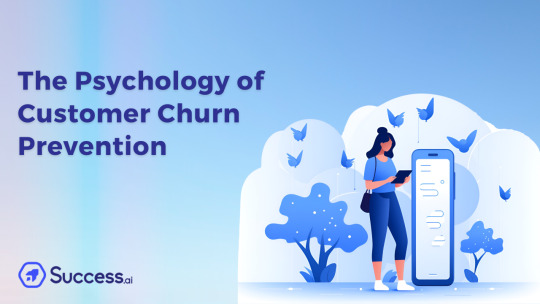
Psychological Triggers of Customer Churn
Perceived Value Decrease One of the most powerful psychological drivers of churn is the perceived decline in value. When customers feel they are no longer getting their money’s worth, they are more likely to leave. This perception can arise from price increases, diminished product quality, or a shift in service delivery. Psychological Impact: Customers may feel betrayed or undervalued when the product or service they’ve come to rely on no longer meets their expectations. This leads to frustration and dissatisfaction. Mitigation Strategy: Communicate openly with customers about any changes, such as price increases or changes to the product. Emphasize the added value and improvements that come with these changes. Offering incentives or discounts to loyal customers can also alleviate perceived value decreases.
Cognitive Dissonance Cognitive dissonance occurs when customers experience discomfort due to a mismatch between their expectations and actual experiences. This tension can lead customers to question their decision and, in turn, churn. Psychological Impact: When customers' expectations are not met, they may experience frustration and regret, leading to churn. Mitigation Strategy: Be transparent about what customers can expect and ensure that your product or service lives up to its promises. Regularly check in with customers to address any concerns or frustrations before they lead to dissatisfaction.
Emotional Disconnect Customers who feel emotionally disconnected from a brand are more likely to churn. Emotional loyalty plays a significant role in customer retention, and if customers feel unrecognized or unsupported, they may abandon the brand. Psychological Impact: A lack of emotional connection can make customers feel that their business is unimportant, resulting in disengagement and churn. Mitigation Strategy: Build stronger emotional bonds by engaging customers on a personal level. Personalized interactions, meaningful communications, and recognition of milestones (such as anniversaries or birthdays) can strengthen emotional connections and reduce churn.
FOMO (Fear of Missing Out) FOMO is a powerful psychological trigger that can drive churn. Customers may leave if they believe they are missing out on a better deal or a superior product elsewhere. Psychological Impact: When customers perceive that competitors are offering more attractive options, they may feel the need to switch, driven by the fear of missing out. Mitigation Strategy: Regularly communicate the unique value of your product or service. Showcase testimonials and success stories to reinforce the benefits of staying with your brand.
Conclusion
The psychology behind customer churn involves complex emotional and cognitive factors that influence customer decisions. By understanding these triggers—such as perceived value decrease, cognitive dissonance, emotional disconnect, and FOMO—businesses can implement strategies to address these psychological drivers and reduce churn. Building strong emotional connections, managing expectations, and offering personalized experiences are key to ensuring long-term customer loyalty.
#Psychology of churn#Emotional reasons for churn#Customer dissatisfaction triggers#Cognitive dissonance and churn#Fear of missing out (FOMO) and churn#Why customers leave psychologically#Emotional connection with customers#Value perception and churn#Customer experience psychology#Brand loyalty psychology#Expectations vs reality in churn#Customer behavior and churn#Reducing churn through emotional engagement
1 note
·
View note
Text
VUILive - Understanding Trends in Content Marketing for Achieving Big Success

Content marketing is a skill of creating fascinating tales to engage and convert audiences and it is at the forefront of this constantly changing environment. Understanding the trends in content marketing is the key to being successful in a world where information is always flowing.
Content marketing is a multifaceted realm, where art meets science, creativity melds with strategy, and storytelling becomes a powerful brand-building tool. It's about crafting narratives that captivate, inform, and inspire, all while driving your business objectives forward.
But in this constantly evolving digital landscape, what worked yesterday might not work tomorrow. To thrive and achieve big success in the realm of content marketing, it's imperative to not only understand the current trends but also to anticipate and adapt to the ones on the horizon.
The Evolution of Content Marketing
Content in marketing isn't a new concept, but its strategies and approaches have continuously evolved. It's no longer just about churning out blog posts and hoping for the best.
The content marketing of today is more sophisticated, data-driven, and customer-centric.
1. Customer-Centricity: The Core of Content Marketing Trends One of the most significant trends in content in digital marketing is the emphasis on customer-centricity. In the past, content was often created solely to promote products or services. Now, successful content marketing is all about providing value to the audience.
Understanding your target audience deeply is paramount. This means not only knowing their demographics but also their pain points, preferences, and behaviour. Armed with this knowledge, you can tailor your content to address their needs effectively.
2. Video Dominance Video content has exploded in popularity and is a dominant trend in content marketing. Platforms like YouTube, Instagram stories and Reels have contributed to the video content boom.
To achieve big success in creative content marketing, consider incorporating video content into your strategy. This could involve creating how-to videos, product demonstrations, or even vlogs that provide insights into your industry. Videos are more engaging and shareable, increasing your content's potential for virality.
3. Interactive Content Interactive content, such as polls, quizzes, and surveys, is gaining traction. It engages the audience and provides valuable insights. Interactive content invites participation, making your audience an active part of the content.
Understanding this trend means recognizing the value of two-way communication with your audience. Interactive content not only captures attention but also fosters a sense of community and involvement.
4. Ephemeral Content
Ephemeral content, like stories on platforms such as Instagram, Facebook, and others, is another trend within content marketing in digital marketing that requires understanding and utilization. These temporary, engaging snippets are perfect for creating a sense of urgency and exclusivity.
Leverage ephemeral content to showcase behind-the-scenes moments, promotions, or daily updates. Understanding the ephemeral content trend within content marketing in digital marketing means recognizing the power of FOMO (Fear of Missing Out) and using it to your advantage.
5. Data-Driven Decision Making Content marketing success isn't just about producing great content; it's about knowing what works and what doesn't. Understanding the importance of data-driven decision-making is pivotal.
Analytical tools can be used to monitor the effectiveness of your material. This includes monitoring metrics like engagement rates, click-through rates, and conversion rates. Adjust your strategy based on the insights gleaned from this data, ensuring continuous improvement.
The Path to Big Success
Understanding these content marketing trends is one thing; putting that understanding into action is another. To achieve big success, consider the following steps:
1. Audience Research Invest time in understanding your audience through strategic content creation. Develop detailed buyer personas, conduct surveys, and analyse data to gain insights into what your audience truly values.
This information will guide your content strategy and ensure that your messaging resonates effectively with your target demographic.
2. Video Content Creation Engage your audience with captivating video content creation services. Our expert team specializes in photo & videography, ensuring high-quality visuals that convey your message effectively.
From concept to editing, we bring your vision to life, helping you leave a lasting impression.
3. Voice Search Optimization It is a pivotal aspect of modern SEO. Crafting content with voice search in mind involves anticipating user queries and delivering succinct yet informative responses.
By addressing potential questions, you enhance your chances of being featured in voice search results, effectively catering to the growing trend of hands-free online interactions.
4. Interactive Content Strategy Boost engagement with your audience through an interactive content strategy. Leverage engaging tools such as interactive polls and quizzes, which seamlessly blend into your website or social media profiles.
Elevate your online presence and user interaction with our expert content marketing services, tailored to maximize your digital impact.
Ending off
Staying attuned to the latest content marketing trends is essential for achieving substantial success. At VUI Live Business, we recognize the importance of not just producing content, but crafting the ideal content, tailored to your target audience, and delivered with precision timing.
By aligning your strategies with these emerging trends, you can elevate your content marketing endeavours to unparalleled heights.
#VUI Live Business#content marketing services#Content in marketing#content in digital marketing#creative content marketing#content marketing in digital marketing#strategic content creation
0 notes
Text
i regret growing up
i’m really sad. at this point, erm age i guess. ok but what if I WAS SUICIDAL!!!!! emotionally saying though, i wonder when will I finally be okay and stop running.
ok but recap > 2020-2021 summer is shit like shit as FORK. i mean, my whole life has been shit, but i feel like everything just made sense at this age now and the realization just broke me apart. first of all i mean, my family is hardcore TOXIC, like seriously i’m supporting them to get a divorce but really it’s hard- mom just went “i hate you we’re breaking up! ... but i’m not getting a divorce because when u pass i want the inheritance!” last month & hasn’t been talking to dad because they’re playing the “whoever talks first loses” game. I have no better words to tell you but yeah the T word! i could make a long fat list about how much of a virgo my mom is & how much of an aries my dad is to my mom merp!!! my friends, i feel like i’m just losing them one by one bc i shove them off as usual and expect them to climb back to me but no the world apparently does not revolve around me! .... i never push people away though, or try to be distant. i just sometimes fomo myself from the fear of getting hurt or used but really, it’s hard to find friends who you can genuinely talk to and not feel like a bummer.
i don’t know if it was the mom trait Ive been churning from since 2 or the “I want a boyfriend but can’t commit”. for real though, if i went to a psychologist i’d probably get diagnosed with “this bitch is regina george fake” note to self : god ur so full of shit. you hate your mom, your friends even your exes before they turn to exes. it’s confusing, hard and just HARD. i never knew what a normal household was until i did feel like my life was so much more different than all the other kids’. i felt trapped and its so suffocating to the point where i build this whole new personality of mine (thx lele pons) pretending happiness til trait turns me into this bubble headed bimbo- not blonde though. through the years, i slowly kinda realised that attention > therapy. well not in a pick me girl way but i’m trying. i’m always really cheery and bubbly in the outside and i swear, i should really get a role in the matrix or something. sHe’s reALLy gooD! *tiktok sound* its true though, when i open up abt something deep no one really gives a f and just laughs it off and it genuinely hurts me a lot. i overthink in most situations and it scares me how much i understand others more than me. my mom on the other hand, she hurts me unintentionally. i’m 16 and i have NO PRIVACY AT ALL. yes girl get it! that’s why i’m always so closed off i guess. last year i had a really shitty eating disorder and i really didn’t think of it as a big thing bc it was personally my coping mechanism. (TW) my fatass depended on puking mentally for my health. i guess i did for a month until mom found out because the SINK WAS CLOGGING. like fuck what in the chunk did i eat for it to even clog the hole?! see, this is why i don’t talk casually to my mom > she thought i was insane and actually really thought of sending me to a mental institution, im not kidding. but yeah once i tell anything personal to her, she’ll use it as a banter when she wants to scream at me which wow mother of the year! way to go!
self analysis: i cope by being past dependent or seeking attention just because maybe i can’t get through problems and choose to run from them, leaving lies everytime everywhere. / or maybe because i’ve always been told repeatedly that i’m never good enough or was not as good as her/him. i choose to lie to myself about this cruel world rather than exploring. am i scared or am i lonely? or am i just not ready to grow up? i hold to things and memories for so long and way too tight that, the bruises comfort me in ways that i didn’t accept letting go, or manipulating my way to grow old.
i’ve recently started reading this book “forgotten girl”. a true story about amnesia and second chances - NOT SAYING i have amnesia or whatsoever. naomi, the writer, had big dreams and yet ended up doing drugs to cope herself from stress and trauma, not realising herself formed heavy bipolar depression. WELL IM NOT #twinflames w her but i know how it feels to turn 16 and everything just feels like “mY life has been a liE!!!??” sighs. i’m just confused. i’ve always thought that life was so perfect where i could dodge whatever missing assessment there was and still able to swerve through college and finally get married or something! but in reality, the phrase “money doesn’t fall from the sky” really called me out this time.
i miss myself, how’d i lose myself to so much tangles of “be GEN Z”, separated culture, or wanting so quickly to get old. i do regret growing up, because then I’d have no idea that mom & dad were out of love, i’d still be hanging out with my primary friends and not pretending a personality to be in the society.
0 notes
Text
Tips to Combat the Adverse Impacts of Covid-19 in Real Estate

Altering the very fabric of our existence, Covid-19 blew out the fun from everything that we once enjoyed, including human interaction. It crippled the global economy as industries were left gasping for air. India remains no stranger to the pandemic's woes, suffering the most brutal hit in its second-largest employment generation sector, the real estate industry. This segment was already grappling with a multitude of complications in the value chain. For instance, real estate projects in Kolkata were stumbling in a pile of unsold portfolios. The customers' lack of enthusiasm created a tepid need for properties, undermined investors, and half-baked ventures dispersed across the country. Pummelled by the government and coronavirus, the real estate industry suffered high toxicities that led to a gradual decline in its worth.
As it was once said, “When things do not go your way, remember that every challenge — every adversity — contains within it the seeds of opportunity and growth.” Now, you know that the damage has already been done. As a realtor, you need to form an attitude of an opportunist, grabbing onto any prospect of recovery. We are here with some digital marketing strategies to help you get through the hardships caused due to Covid-19 in the real estate sector. Let us dive into it!
Take the Digital Leap
Harnessing virtual platforms' power to exponentially grow your customer base seems like a significant option during such challenging times. Individuals have become apprehensive about the whole health spectrum, maintaining social distance wherever necessary. You can intrigue the buyers into your bidding by imploring them to join in Zoom, wherein you can share a PowerPoint presentation to introduce the property to be sold. Or you may utilize social media avenues to post about the houses, “2 BHK flat in South Kolkata available at a great price”. Sharing creative pictures and videos while maintaining proper customer care would increase your stance in closing a buyer.
Keep People Up to Date
By engaging in a direct conversation with your clients over social media networking sites, you can monitor if your strategies are working. Sustain an evolving plan that modifies with the prospective customer’s preferences and requirements. By enabling people to know about the latest developments and information in the sector, you portray yourself as a credible and authoritative brand. Folks prefer to do business with companies whom they can trust and rely upon, an age-old concept that still stands true. You have the opportunity to get in touch with such prospects over Instagram or Facebook and then eventually attain their numbers and email-ids. This way, you can send them fresh deals and customized offers tailored to suit their budget and requisites.
Customers are Sceptical, Ease their Concerns
Before you keep expectations of receiving a customer’s direct message asking, “Kolkata 3BHK flat price”, you must accommodate room for their fears and concerns. Now, it's about providing them with incentives that would encourage them to build trust and connection. Try to engage them in a profoundly imperative topic, measures to upkeep the health and safety of buyers and workers in physical spaces.
Safety Precautions for the Workers
Ensure to design Covid-19 safety protocols at your site for the workers. You can’t afford one of your people to fall prey to the virus; otherwise, the whole area would be sealed. Maintain a strict rule of social distancing and wearing a mask. Also, make sure that they are sanitizing their hands at a regular interval to steer clear of any threats.
Develop Client-Developer Relationship
It is essential to be empathetic while dealing with such uncertain situations. Show support to the existing clientele by understanding their financial condition. The pandemic wreaked havoc on everyone’s mundane lifestyle; by displaying some sort of consideration at the time of purchase, you will be able to earn goodwill. While simultaneously increasing your chances of being referred to other people by the client.
Product Development
You must always gain knowledge about what is trending in your industry. This will help you in tenant attraction and churn commercial rent concession. Every day or the other, several trends emerge that call for an improved architectural design to boost the living space's functionalities. Before the pandemic, co-living and luxury student housing facilities were the talk of the town. However, it's long till people can recover from the negative impacts of a shared economy. Currently, individuals are more inclined towards owning an additional work-from-home space at their residential apartments. Keeping up with the evolving fads will help you stand out from the crowd.
On a side note, the application of AI-powered services like the integration of chat-bots will increase your demand in the market. By introducing such concepts, you will render computerized solutions to the user’s basic queries. In case they require further assistance, the prospect would leave their contact information for you to get in touch with them.
Grab People’s Attention by Offers and Discounts
It has been estimated that real estate values dropped down to around 25% in several sectors whereas, for lodging, the value plunged to 35%. It's crucial to grasp people’s attention by offering them deals and offers that they can’t refuse. Covid-19 has served you with innumerable ideas when it comes to providing incentives while selling properties. We have mentioned a few below, check it out-
Low booking amounts- Allow your clients to rummage through your profile so that they can witness low booking expenses. It’s a win-win situation; you gain profits while they can save money.
GST discounts- It would appeal to several keen buyers as GST discounts will grab more attention. As it would help individuals to spare a good fortune.
Ready-to-move-in apartments- Considering the given situation, folks would love the idea of a fully furnished place. Saves time but gets the job done.
Zero cancellation charges- This proves to be a marvelous motivation for buyers as they won’t be charged a single buck in case they plan to cancel their bookings.
Attractive prices- Give them a price that they can’t deny, something that will induce the feelings of FOMO (fear of missing out).
Conclusion
The real estate industry will be on the path of steady recovery in no time. Actively participate in digitalizing your business to gain paramount advantages. If you require a one-stop destination for all your needs, trust your local search engine for verified results of property dealers and realtors listed under the Kolkata business directory.
#2 bhk flat in south Kolkata#real estate projects in Kolkata#Kolkata 3 bhk flat price#Kolkata business directory#2 bhk flat for sale in kolkata#3 bhk flats for sale in kolkata#3 bhk flats for sale#local business listings#find local businesses in Kolkat#business directory for Kolkata#Free business listing in Kolkata
0 notes
Text
The grass is always whiter on the other side...

There’s a lot of eye rolling in this house when mummy churns out one of her old ‘Boomer’ phrases and, outraged, cries: “What? Have you never heard that expression?”
I love language you see; I love idioms and proverbs and I love giving my son new…oh alright then, old… ways of expressing himself.
I also like to customise them, although this did backfire once. My son came back from school and told me he ‘got told off’ because he argued with his teacher that Practice Makes Progress. It happened because I’d noticed that I had unwittingly passed on to him my somewhat faulty perfectionist trait – and so I’d decided to try to phase out in him the need to strive for perfection while beating himself up for anything ‘less than’. So, I started repeating to him that practice might not always make perfect, but it makes progress. ‘Practice Makes Progress’ became a thing, and worked just fine until his Year 3 class (loosely) studied proverbs. Poor boy. When his teacher told him what he’d written was wrong, he argued that she was wrong! (I like to think that she has now seen the error in her ways and will help spread this improved proverb far and wide).
I’ve customised another one this winter, although this one is a bit more niche: The grass is always whiter on the other side.
Here in beautiful, coastal South Pembrokeshire, the very westernest edge of West Wales, snow – let alone settled snow – is rarer than Action Man’s tears.
Four times in the past month I have blinked in disbelief because I’ve seen snow on the weather forecast. Twice it even heralded the imminent arrival of “heavy snow”. Three times I have got seriously over-excited. And three times I have been utterly crushed when I’ve woken up to heavy rain. I’m not the only one. A friend told me the snow looked like such a cert last week that they’d already lined up their sledges the day before. Sledging doesn’t work so well in a torrent.
Now you probably don’t need me to tell you that disappointment in these virus-spoiled times is amplified beyond all reason, and can morph into dejection and hopelessness if you’re not watching.
The third, crushing, no-snow-blow resulted in me declaring an afternoon off work and home-school as I hurriedly organised a No Snow Festival. This consisted of camping out in a tent in the lounge and basically doing any activity I could think of to prove (to myself, mostly) that it was possible to have fun without snow. We put on ‘festival’ clothes, munched brownies while watching old Glastonbury footage on iPlayer, forced our dog to perform in the ‘Dog Agility Arena’, enjoyed a Dance Workshop with Oti Mabuse, held ‘No-Snow’ themed colouring competitions and a culinary masterclass in which we let our son ‘teach’ us how to make guacamole… there was more.

Meanwhile, all over Facebook my friends across England, Scotland and mid Wales could be seen frolicking in the beautiful fluffy white stuff. The first time that happened I was happy for them. I loved seeing their (smug) snowmen and (joy-filled) sledging videos. But then it happened again, and again, and again… and all of a sudden, they’d had more snow in 3 weeks than we’d had in 17 years! To my shame, my responses to their good times became increasingly bitter (always with some smiley emoji to disguise the pure venom).
I know I have been a total bore about it and – snow-blessed friends, I am sorry.
But the thing is there is something worse than FOMO, and this time it was my son who customised the phrase. He said: “Mum this is not FOMO, this is AMO. Not just Fear Of Missing Out, but Actually Missing Out.” Damn straight, kid! It sucks!
On the fourth time snow was forecast I determined not to allow myself to get excited. (I’m a slow learner). This was also because my (increasingly wise) boy had said to me: “Do you sometimes wish there wasn’t a weather forecast?” I stopped looking at it. I couldn’t cope with any more disappointment. Here goes a proverb, from actual Proverbs in the Bible: “Hope deferred makes the heart sick.” No need to customise that one.
Naturally, of course – and feeling like a reward for my new-found wisdom – that’s the one time it actually snowed. A teeny, tiny little speckledy smattering. Up against the walls and in corners it settled. And there was GREAT REJOICING! We pulled on whatever clothes were closest and rushed out to play! I mean, just look at this epic snowman!

After about ten minutes of excitement and freezing-fingered fun, when it became clear we weren’t getting any more, the little man said to me: “I can’t work out whether to be happy or disappointed.” Seems it’s possible to feel both, because I did.
But then, we’re by no means the only ones who’ve been experiencing AMO during this EWL (Evil Winter Lockdown).
We may have no proper snow but we sure do have proper beaches. It may take us over an hour to walk there, but our two local beaches are pretty much the most beautiful in the country.
During the first lockdown I experienced an awful lot of that most useless, energy-wasting of emotions: guilt. Guilt over the fact that we had not only a garden, but also a field, for daily exercise. Guilt that we could walk to the woods, which lead to a National Nature Reserve, which leads to two of the loveliest beaches in the Pembrokeshire Coast National Park. Guilt knowing that not only were we Covid-free and didn’t work in the NHS but that we enjoyed such privilege – being able to access such beauty and playgrounds – while others were going through the toughest of tough times and with none of that on tap.
My snow-happy, land-locked friends have often expressed their own envy at our ‘living on holiday’ because we live by the sea. I also imagine that if you live in fire-ravaged California or Australia, where the sun always shines, you might take the occasional wistful look at the green, green grass of wet West Wales.
The idiom goes “The grass is always greener on the other side.” It’s thought to originate centuries ago, possibly stemming from the ancient Roman poetry of Ovid who wrote: “The harvest is always more fruitful in another man’s fields.”
But in truth, the grass is greener, or whiter, or sandier, or wetter depending on where you are standing.
Comparison really is the thief of joy. I am yet to be able to pass on any wisdom as to how to overcome the punishing tendency to compare yourself or your circumstances with others.
I guess the challenge is to tend to your own grass as best you can and extract the pleasure from its upkeep without needing to check on how your neighbours’ grass is looking.
I’m not great at that, if I’m honest. Ah well, Practice Makes Progress. 😊
0 notes
Text
The good SaaS times will end and challenges are coming
Ed Byrne Contributor
Share on Twitter
Ed Byrne is an entrepreneur, investor and co-founder of Scaleworks.
More posts by this contributor
Working backwards to uncover key success factors
Netflix is still too cheap
We’ve had a great decade-long run in SaaS — abundant capital, a thriving economy and a massive existing market shift from on-premise to cloud.
But the good times will end and challenges are coming.
I’m not predicting when it will happen — maybe it’s the spread of COVID-19, or perhaps the market recovers and goes on to set new records — but one thing is for sure, recession will come, it always does.
Because a lot of SaaS leaders have never run a business through one, it might be helpful to share some ideas on how to be ready for the inevitable slump. One of the greatest assets a SaaS business has is high-margin, recurring revenue — that should provide more leeway in making changes to get through a downturn than many other types of businesses.
I’ve broken this guide into the macro — things that happen to you, the levers you can impact in your business and some notes on how to keep your stakeholders supportive.
Funding environment
Credit tends to dry up in a recession, but luckily for SaaS, bank debt has never really been available, so it’s unlikely this makes much difference! The new breed of SaaS debt providers should be able to keep providing credit through a recession, as they understand the real asset of recurring revenue. They may get more conservative in the amount of money they will loan, especially if signups are down and churn is up, but debt should be more available for SaaS than in other sectors. Make sure you know your funnel and install base metrics — these should provide confidence to a lender.
Who knows what’ll happen with VC. There has been so much money raised by new and ever-expanding funds that they may keep investing. Valuations are likely to drop and the world will move more investor-friendly than founder-friendly, and check sizes will drop in line with valuation for VCs to get the same equity for less money. Good business is good business in theory, but “growth at all costs” is harder and more expensive in a recession. Where FOMO (fear of missing out) drives VC in good times, plain-old fear holds them back in bad ones.
Customers and the addressable market
This is nuanced, depending on from where you win customers. Do you save them money over their existing solution? Or cost them more money than how they do it today? Even if their current solution isn’t a good one, the sales pitch for change is much harder in a “batten down the hatches” world than a “shoot for the stars” one.
If your customers are moving from old-world on-premise software, you should be in good shape, or even in better shape as they accelerate the move to SaaS, which saves them money and reduces overhead and capital.
Customers who do what you offer in-house could be a slower, harder sell. This model is already tough — it’s all about customer timing and being front-of-mind when they are ready — but you can be sure most projects will get shelved or postponed by customers who are reacting to the downturn and its effects on their business. You’ll have to work extra-hard on white-glove onboarding to remove cost and hassle and make sure you have a credible ROI narrative that will rank your product highly on the new short-list of projects that stay approved.
If you’re winning business from customers moving between SaaS tools — like someone swapping out Jira (a SaaS project management tool) in favor of Asana (another SaaS project management tool), just make sure you are the clear “recession-choice” provider, otherwise the flow might go the other way and not only will new sales drop, churn will increase.
Then there’s the new project sale — selling a solution that doesn’t currently exist inside your target customer.
Maybe it’s a new way of doing things, or a product built for an emerging market with low competition (but low awareness, too). Think recurring revenue billing for SaaS: This problem is SaaS-only, and SaaS is still relatively new — it’s unlikely a customer is using QuickBooks! Or remote team management software — remote teams working on computers all day is a new phenomenon. In a recession, all new projects are going to get ranked by must-do and optional, and the must-do list by impact and speed of impact to the bottom-line. Be able to 100% prove you can deliver value quickly.
Infrastructure costs and credit cards
There’s always some room in the hosting and DevOps setup — you don’t want to take risks — but if you’re like most SaaS companies, cost optimization hasn’t been the top priority because you’re growing and gross margins are already so high. Optimize AWS (or whomever you use) — make sure spot and reserved instances are used where possible, you’re running the appropriate instance sizes and all running instances are actually utilized. Reduce or cut optional monitoring and DevOps tools — there’s always a little overlap here.
Audit your credit card statement — do you really need all those SaaS tools? Or better yet, cancel your credit card and get a new one — only re-add the tools you want as the dunning emails come on. I guarantee you’ll find things you’ve been paying for that you didn’t even know about.
In fact, consider getting rid of company credit cards; they get overused and bad habits seep in. When expenses have to be justified to get reimbursed, the number seems to magically drop a little. The burden of proof makes people act more frugally.
Cash and finance
Know your cash. A simple statement, but unfortunately, it’s rarely the case. You can’t rely on stories, promises and spreadsheets — you need to log in to your bank account multiple times a week. This isn’t hard and you’ll build a gut feel for your cash position and its movements quickly.
Know your cash revenue. Annual and Monthly Run Rate (ARR/MRR) matters, the Profit and Loss account matters, but in tough times, cash is king. If you get low on cash, and think you’re profitable because your P&L says so, you run a serious risk of going out of business.
Cash forecasting is essential — your run rate and your cash often don’t correlate — any pre-payments show up in revenue, but you don’t get that cash every month, so it may already be gone. The same goes for booked revenue that hasn’t paid and sits in aged accounts receivable (AR) — again, revenue but no cash.
Optimize your Deferred Revenue and Accounts Receivable. Try to get more pre-payments without giving too steep a discount — bolstering your cash position. Who owes you money? Chase it. You can’t afford to have a system on — regardless of the margins — if a customer isn’t paying for it.
You must take the “no-surprises” approach to running finance. Any payments above a (low-dollar value in recession world) threshold — the CEO should approve.
People
The team is the most expensive and important asset in every SaaS company. But, if you go out of business, you’ll lose all of these assets, so it’s essential to make the hard choices in time.
That might mean voluntary or involuntary exits. You could literally ask those who believe in the vision and long-term to raise their hands and tell you who they are. It might mean the end of a bonus structure. It might mean asking people to take salary reductions (it’s pay cuts or headcount reductions — depending on the team, the leaders need to figure out which puts the business in better shape).
Assess your cultural norms — do people really value free snacks, lunches, a book allowance and so on? You don’t have to zero-out your culture, but there’s lots of things you can do (like a potluck where everyone brings in food and cooks for each other) that are great fun, build camaraderie and are cheap or don’t cost anything.
Existing customer base
In a recession, these are your most prized assets. You need to show them you are here for the long-haul and are still investing in providing the best product, service and support. Start customer advocacy programs, share more customer success stories and connect groups of like-minded customers together. When new sales drop, retaining existing customers is absolutely essential for the survival of your business. Invest more here during a recession.
Pricing
Many people’s first reaction in a downturn is to reduce price. Resist this! First off — it instantly reduces your margins and your free cash flow. Then, if you don’t reduce price for existing customers, you’ve frustrated your install base as well as hurt your bottom line.
Price is a signal — to customers, the market and your team. Businesses that price-cut send a signal that they are in trouble, need cash and are prepared to take a hit to get it. This is not a strategy to attract long-term customers!
Additionally, it’s damaging to a business to attempt one-off “recession pricing,” because once you come out of it, it’s nearly impossible to regain the premium brand and price you once commanded. Price decreasing is a one-way street.
You do have levers — work with customers on payment plans, on ramp-ups or regular usage audits and on pre-payment discounts. You can tweak your pricing model to keep prices where they should be while reducing the burden on your customers — a policy that can easily be retracted post-recession.
Communicate
With customers, with stakeholders, with employees.
Lots of companies are so focused on building the business that they forget to give “business updates” to their community. That’s okay when the updates are great and everything is praiseworthy. But when the world is shaky — regardless of whether your business is or not — all your stakeholders will be nervous. Tell them what’s happening, give them confidence that you’re in the details and have a plan to address every area of concern and risk.
Do this early — not when you’re already in trouble — and your community will realize you’re one of the few solid companies with your heads firmly fixed to your shoulders.
Summary
Recessions come and go. This is the first test of the durability and resilience of SaaS companies — but there are sources of power with recurring high-margin revenue. Be conservative. Increase transparent communication. You can, and should, think long-term during a recession: make it through the short-term but don’t destroy your brand, community and company cultural equity to do it.
Whatever you do — remember your customers and employees will remember it when the economy starts growing again. Act responsibly.
This is by no means intended to be an exhaustive list or complete plan — I’d love any recommendations to other articles and guides that might be helpful for our SaaS community in Scaleworks — message me @edbyrne or email [email protected]. Thanks!
0 notes
Text
Problem With Comic Books
Comic book movies, they are always box office hits. Why? Because people like familiarity. Let us say you were a kid who grew up on comic books, then as you get older you see your favorite characters from the same comic books on TV and on the big screen. You will go and see them. Because as a child you identified with these characters, it is a genius marketing move and one that is almost always going to be profitable. Studios love stability. Studios like a steady flow of income so they churn out the same superhero movie 1, 2 or 3 times (Spiderman) or, even though the best possible version has already been shot by Christopher Nolan, you shoot the same Batman movie for the billionth time. Studios know that people will always pack seats for superheroes so they don’t feel the need to be creative, or try something innovative. That’s okay because the world is going to end anyway why not give the people what they want?

It’s okay that studios want to make money off the same movies and it’s okay that people are willing to see the same movies over and over again. What’s not okay is 2 fold:
1- Studios creating transmedial universes for their franchise movies to sell products like toys and things which do not enhance the story or universe in any way other than lining the pockets of the rights owners.
2- People identifying with characters so much that they feel offended when a person of a different race is cast to play the lead in a superhero movie.
The problem I have with companies like DC or Marvel making side attractions like toys or wierd little side-quests from their movies is that sometimes it feels like the corporations are just milking people’s sense of FOMO (fear of missing out) to cash out on pointless things. It’s like if you don’t know this specific quirk of a character or you don’t own the one-of-a-kind action figure, you’re not really a fan. Granted, I’m not a fan of superhero movies, but I still feel the need to defend the people who just want to watch the movie without having to memorize some weird niche knowledge, dammit.
Actually the second problem I have with the superhero movies is more serious than the first, in that Most superheroes are drawn white. Black people don’t get much of a representation in comic books or in the adaptations. So when white characters are adapted as black to movies, fans are most of the time outraged. I don’t really get why people get so heated over race anyway, In the end it’s never that serious, it’s just fiction.

0 notes
Text
My Son Is Two Years-Old And I Already Feel Like He Needs Me Less
Now, when I help my son from his crib in the dark of the morning, he hooks his feet around my side. His hands start grabbing for purchase. In what feels like one move — a toddler jiu-jitsu guard pass — he’s adjusting his grip on my collar and pulling himself to face me head on. Then we’re chest-to-chest, his feet drumming against me.
He narrows his eyes and leans over my shoulder to try scour the dimness. After a moment, he turns to face me. He says “dah dah” like a pilot whispering the instrument’s name while they check it. In a moment, he’ll say “down,” push his hands against my chest, slide down to the floor, and start trundling around the house, the first blues of morning sliding through the shades.
ADVERTISEMENT
Two years old, and my son Winslow’s already begun shedding needs. That’s expected. My wife and I do less for our son than we once did. He believes that he needs us less, too. He’s not wrong. But, for me, it’s less expected.
Still, the dark, from dusk until mid-morning, was my thing. I worked the third shift of parenting, along with the odd hours, and drop-everything-and-go-do-Y-because-X-happened availability. The idea my son needs less the thing on which I rested my parenting killed me for a while. If I didn’t provide this one loving service, what good was I? What would my son know me as?
Featured Video
Loading Video Content
It had been a parallel pocket of time, those strange infant nights. It was ending. It felt like either one week or 20 years had passed. My son was a different creature now. That’s was my only concept of ‘time.’ But what had I done? How could I measure it? If he was different, had I changed?
***
Out of life’s requirements, routine forms. My wife’s intense corporate job starts at 7:30. She’s up at 6:15. She dresses to the nines and slides out of the house with a preternatural quiet. Winslow starts crowing and shaking his crib bars by seven (happily, a few aspects of early parenthood’s animal husbandry linger).
His voice wakes me swiftly, as it has since he was little. Even a cough has been enough to summon an Undertaker-esque instant sit up since he was weeks old. My son was born during the second year of my wife’s MBA. Because of asinine rules and the doofy unpreparedness of administrators, she had to resume classes four weeks after giving birth.
My wife and I do less for our son than we once did. He believes that he needs us less, too. He’s not wrong.
ADVERTISEMENT
That’s when my night shift began. I would be at home, with a few blessed hours a day of child care — enough for errands, the gym, a shower. And then with him, with him, with him. Feeding, holding, loving, adjusting playscapes, piously churning through cloth diapers (yes, we were those parents), often letting him toil through tummy time while I cravenly look at Twitter nearby, desperate, desperate to have some connection to another world.
In those small moments of self-preservation, I was “missing out” in some way. I notice this now. I missed some adorable roll of his head, some new chirp. But the very idea of missing our child’s childhood feels baked into the experience of parenting. There is nowhere where the petty searchlight of “FOMO” cannot see you. So the bargain I made my with myself was to own the night. My wife needed to sleep. I had a few hours to myself during the day. It felt only right.
At seven months, it was coaxing Winslow through a brutal week of RSV (respiratory syncytial virus) our son coughing and struggling to find a way to sleep.
At around one year, it was overnight dirty diapers created by the ever-expanding dinners that his ever-expanding appetite demanded. I didn’t need a single light; so fluid were my moves of scooping him out of bed, removing and disposing of his diaper (we had the good sense to switch to disposables by then), clean him, dry him, give him water, cuddle him, and return him to sleep.
ADVERTISEMENT
The sensation of him holding my shoulder during those nighttime routines, letting me place him back in the crib, turning to make that strange, beautiful eye contact that one-year olds can make — half skepticism, half ardor — before flopping onto his crib mattress and returning to sleep, gave me more sense of purpose than anything else in my life.
Had I ever been so competent in anything ever?
Sometimes at around 15 months he’d just wake up in the middle of the night. I’d hear his chatter flow through the baby monitor. I’d go see him, and he’d be standing up, seemingly waiting for me. He’d smile, I’d lift, cradle, check his diaper, smell nothing, kiss him, talk to him, and set him back down, my hand on his back as he wriggled back to his sleeping pose, butt in the air, head to one side.
The very idea of missing our child’s childhood feels baked into the experience of parenting.
ADVERTISEMENT
We had hired a nanny last summer, one who loves Winslow, who takes him on adventures, who has been wonderful enough to introduce our son to her family, to make his world bigger, fuller. She takes him places I don’t. She witnesses “breakthroughs” (or whatever development word of the moment you prefer) that I miss.
My wife loves our son intensely, plays with him and teaches with him and shapes his everyday world like gravity and blueberries do. She is also the breadwinner. The physical world he lives in is because of her success, her talent, her work. Their time together before bed and on weekends feels sacred. I try to play a supporting role; I try to facilitate.
Is this missing out? I don’t know. He’s not reaching for my hands when we walk together through a new place as a family.
Now, he, his little two-year-old colleagues, and his teachers launch their own adventures during the two half-days he’s in school. Each day the school sends photos of the children’s’ activities to us. The reports have said that my son is very good at picking things up and depositing them into their respective boxes.
ADVERTISEMENT
Is this missing out? I don’t know. He’s not reaching for my hands when we walk together through a new place as a family.
If you are privileged and lucky enough to find reliable, good, safe childcare for your kid, you’ll be missing out. Yes, you can go to the gym now and tend to your own ambitions and snack in peace, but you are missing your child. You will miss them waving at strangers and trembling in fear at a dump truck by the park and hugging someone else, but you do have your own aims for your life apart from your children, right?
We should forgive ourselves for letting ourselves live under this gelatinous mood, but it’s right and just to remind ourselves that we are not parents separated — for years or forever — from our children by war, incarceration, or migration.
We are separated — for hours — by jobs and ambitions and our own daily desires. When I think back on my two years of parenting, I don’t feel sad for things I missed, I feel sadness for letting moments of regret fog my heart on the arbitrary Tuesday morning in our backyard, my son snickering as he takes birdseed by the handful and tries to toss it into our feeder.
ADVERTISEMENT
On parenthood, Italian writer Natalia Ginzburg wrote, “we only remember to talk to God when our baby is ill; then we tell him to make all our hair and teeth drop out but to make our baby better. As soon as the baby is better we forget about God; we still have our teeth and hair and resume our petty, tiring, sluggish thoughts again.”
When I think back on my two years of parenting, I don’t feel sad for things I missed. I feel sadness for letting moments of regret fog my heart.
The months of parenting in the dark, when the world around my son and me creaked in the silences. That was the way I chose to live best in my child’s time. I’m grateful to remember how clear my mind was in those moments, how clear it can be still.
Now my son understands the dark. He knows when it’s morning and when it’s the off hours. He’s begun to be a bit cowed by the austerity of one AM. When the rare overnight wet diaper wakes him, he calls out loud and clear, sometimes the word “diaper,” sometimes just a cry. When I get to him, he’s crouching in the dark, startled and unsure by it, waiting for his father to help — and I am there too, waiting to help my son.
ADVERTISEMENT
Source: https://bloghyped.com/my-son-is-two-years-old-and-i-already-feel-like-he-needs-me-less/
0 notes
Text
10 Best Ways to Use FOMO to Boost Sales for Your eCommerce Store

Whether it's a brand new online venture or a long-standing e-commerce store, you have certain goals to achieve that are imperative to the success of your business.
One of them is to engage more visitors and drive your online sales. However, certain triggers can help you boost your online sales. FOMO is a form of marketing that can help you acquire more customers and retain them while also ensuring their trust and loyalty.
What is FOMO, and how can it help your eCommerce venture drive conversions? Read on to find out.
FOMO And eCommerce – What's The Connection?
FOMO or the Fear Of Missing Out refers to a psychological trigger that's usually difficult to resist. It is a feeling of regret caused by the loss of a great opportunity or an amazing deal.
It also explains why some people try to catch every opportunity so they can avoid regretting missing out on it later.
As more social platforms continue to pop up, and more people try to live an insta-worthy lifestyle, the effects of FOMO have multiplied significantly. According to PEW research, three-quarters of Facebook users open their account on a daily basis, giving businesses a reason to devise a well-rounded strategy for social media marketing.
Using the tools for Facebook ads to augment promotional campaigns is a surefire way to remind your fans and followers that you can help enhance their lives.
The anxiety and fear associated with missing out are crucial drivers for social media engagement as FOMO induces people to explore and try out new opportunities.
So, what does this mean for an eCommerce website? You can benefit from this Psychological behavior of humans in numerous ways. Besides, you can also boost brand awareness, recognition, improve the customer journey, and ultimately, drive conversions.
Your eCommerce business can effectively leverage FOMO marketing techniques to boost sales, but how? When visitors realize that others are purchasing your products, it entices them to buy from you because they don't want to regret thinking about it later.
7 Best Ways To Use FOMO To Boost Sales For Your eCommerce Store
This psychological anchor can help your eCommerce business drive sales and conversions. In fact, 60% of the customers buy products because of the FOMO effect, typically within 24 hours of seeing them. And that's great news for your business.
While there are various customer acquisition tools out there, there's no magic bullet that can help you generate sales – it's easier said than done. You'll find that with a FOMO-powered marketing campaign, customers will willingly jump on the bandwagon so that they don't miss out on an amazing deal or a once-in-a-lifetime-opportunity.
Here are the 10 best ways to use FOMO to boost sales for your eCommerce store.
1. Limited Time Offer Does Wonders
Time is a crucial factor that can help you trigger FOMO in your target audience. Naturally, if a deal lasts indefinitely, it will certainly not prompt the audience to take action. After all, if a product is available 24/7, possibly for the rest of their lives, why would they rush to buy it?
Therefore, restricting the time of a giveaway or an offer helps you establish a sense of urgency in your visitors. When you offer a discount or introduce a deal, you can set a time limit for those. In short, provide better incentives for customers' early decisions.
Once your consumers recognize that they can reap the benefits if they act out fast, this can induce them to make an instant purchase.
For instance, you can launch an offer with a limited time discount where the amount of value reduces with each passing day. This will compel people to rush their buying decision so that they can avail the maximum discount rate.
FOMO eCommerce Example: Macy’s

For example, Macy creates a compelling copy that uses "lowest prices of the season" and "hurry — ends tonight!" to alert the consumers about the sale. Customers can enjoy these greatly discounted prices but within 24 hours.
2. Display Sales Activity In Real-Time
Showing real-time sales activity to your audience is one of the simple yet powerful ways to incite FOMO. When a user visits your website and sees that other people have been buying your products, it will entice them to get those products for themselves.
You can display the real-time actions of other users to tell website visitors that people buy your products frequently. These sales notifications help the purchase decision easier as it communicates to them what people are buying and encourages them to head to the checkout and buy your product.
The FOMO plugins and other tools can integrate with your ecommerce platform and help you implement and monitor the real-time customer activities on your website.
Additionally, you can use some of the best chatbot apps for your website to ensure your recipients are getting timely responses, and ultimately, reduces customer churn.
You can also adopt the best practices for live chat to assure that the website traffic gets adequate customer support and care.
FOMO eCommerce Example: Booking.com
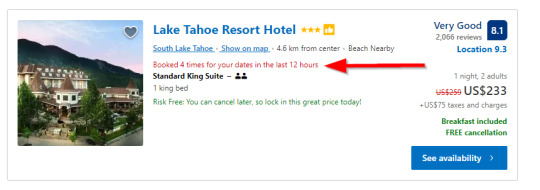
The above example of Booking.com also demonstrates this technique. Their website mentions the number of times a certain hotel has been reserved in the last few hours to persuade visitors to take action.
3. Leverage User-Generated Content
Leveraging user-generated content is yet another way to use FOMO marketing in order to entice your potential customers to want your offerings. Showing something tried and tested to your possible audience is an effective way to trigger FOMO.
You can do that by adding legitimate user-focused content on your website. Encourage your customers to share their brand-related experience. You can also showcase real customer's stories, pictures, and videos with your product to make your audience want the product as well.
Along the same lines, real customer videos of using your product aspire the audience to live that life. This lays a foundation for a powerful FOMO marketing tactic. In fact, 84% of buyers confide in online reviews when it comes to online purchases.
User-generated content, in a way, also acts as social proof and vouches for your brand's and its products' authenticity. It entices the customers to share your products and service-related content and interact with your brand, which develops a sense of FOMO in your followers.
FOMO eCommerce Example: Wayfair

For example, FOMO marketing technique used by Wayfair encourages its customers to share real images of their products using the hashtag, #wayfairathome. This helps them promote their offerings to their followers. People have made over 50K posts with this hashtag. It's a strong strategy that helps boost loyalty, awareness and captivates new customer's attention.
4. Highlight Missed Opportunities
When you showcase the great opportunities that people have missed, their FOMO rises even more. This FOMO marketing tactic intends to persuade people to buy a product by making them realize that they lost the earlier opportunity because they didn't act out fast.
For this reason, overlooked opportunities create FOMO and anxiety for other options. It convinces people to make a purchase and pushes them over the edge, especially if they needed to buy that specific product in the first place that they missed.
Mention about all the great deals and products that are sold out to your website visitors to make them realize what they have missed out on. Let them see upfront the products that are out of stock.
FOMO eCommerce Example: Booking.com

Booking.com 's example also excels in this form of FOMO marketing. When you search hotels for reservations on Booking.com, it also lists the fully booked hotels with a clear-cut message in prominent letters that says, "You missed it!" This triggers FOMO in the audience even for the hotels that are available for reservation at the moment.
5. Display Low Stock Levels
Nothing triggers FOMO better than scarcity. Naturally, nobody wants to miss out on a great product just because it's running out of stock. So, if you have limited items in stock, make sure your customers know about it. It will urge them to take action instantly.
However, it is imperative to display the stock levels strategically that convinces the visitors of the product scarcity. Don't be too generic about a product like, "Only a few left". Instead, share the specific inventory levels that will actually push the audience to act quickly.
Your website visitors aren't imprudent, they would want you to be clear on the stock levels as to how many items are left to elicit an instant action.
Need help marketing your eCommerce store?
Book a free call to learn how our team of eCommerce experts can help you generate leads, boost traffic and drive MORE sales.
FOMO eCommerce Example: Amazon

Amazon does a great job when it comes to displaying scarcity of a product. It precisely shows the stock levels as "Only 16 left in stock – order soon" and entices the visitors to order soon, or they'll miss out on something good.
6. Offer Exclusive Products
Both limited quantity and limited-time products can create a sense of urgency among the audience. But limited-quantity items become more desirable as buyers can't get them once products are sold out.
FOMO eCommerce Example: Heinz
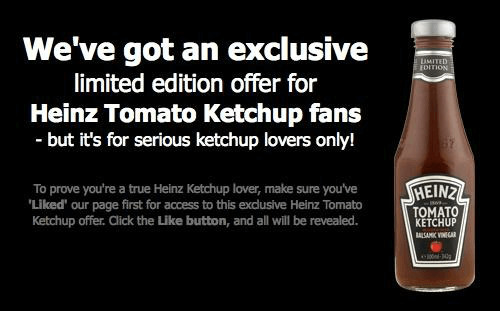
In the example above, Heinz created a compelling FOMO deal by combining its product with time-based scarcity. We, as human beings, love exclusivity. It drives FOMO like anything when we don't want to miss on the opportunity very few people can have.
Think about Amazon Prime and the fact that over 100 million people have subscribed for their service just to reap the additional deals and benefits that other Amazon shoppers can't avail.
FOMO eCommerce Example: Amazon

Amazon Prime Day sales deals play on customer’s FOMO. In 2019, it ran the annual day deals only for 48 hours. It made sure that the customers turn to the Amazon store to satisfy their needs by availing discounts.
Interestingly enough, the retail giant offered the biggest discounts as it helped them sell 100 million products. After all, buyers don’t want to miss out on such deals.
While Amazon is one of the great FOMO marketing examples, you too can leverage exclusivity by introducing limited-edition products or services.
7. Provide Social Proof
At first, it can be challenging to get people to trust your brand. Unless they find your brand credible, it isn't easy to persuade them to make a purchase. Giving social proof can help you develop the audience's trust in your brand.
However, you need to be tactical about when to give your audience this slight boost. In many cases, the best time to do this is when a visitor is about to buy something. You can share customer reviews and testimonials, which can build and augment their trust in the brand.
The testimonials and reviews of satisfied customers can create FOMO that they'll miss out on a great product if they don't act out fast.
While all kinds of testimonials have an impact on consumer’s behavior, good reviews can make them feel left out while other people are purchasing a product, this will incline them to purchase.
FOMO eCommerce Example: TrustPulse
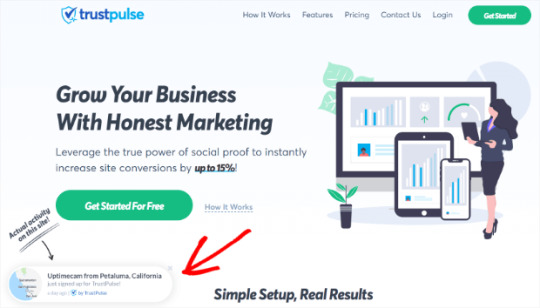
Your customer's FOMO will be even more triggered if you make use of social proof notifications by leveraging applications like TrustPulse. This app displays the name and location of the person who lets your potential buyers know that a real customer/person gives the review.
These pop-up notifications usually appear at the bottom of the display screen and show the visitors that people are ordering from you, which inclines them to buy their desired product from you.
8. Boost FOMO with Email Marketing
Email marketing campaigns remain unbeatable when it comes to reaching your customers. Where around 90% of the customers leverage emails, it's a great technique to boost FOMO marketing.
Furthermore, email marketing is one of the most cost effective marketing techniques you can use.
According to the Digital Marketing Association, email marketing can create a 4300% ROI when businesses successfully utilize proven email marketing services such as ConvertKit or Automizy with advanced features and integrations.
Email marketing, coupled with any other FOMO marketing technique, can be an effective way to reach out your intended audience and induce them to take action. For instance, you can send out emails to:
Let your subscribers know about exclusive rewards or deals
Alert them about the limited quantity of their saved items
Remind them about the items in they added in their shopping cart along with cart abandonment discounts or messages
Send follow up emails with an appealing offer
Furthermore, you can leverage subject line tester tools to come up with an email subject line that interests the recipient and make them take action.
FOMO eCommerce Example: Neil Patel

For example, Wayfair sends out an email to its subscribers on the Independence Day with a subject line, "July 4th Blowout | Up to 70% OFF starts NOW". This creates a sense of urgency in the readers and also triggers FOMO while pushing them to avail the sale offer.
Not sure how to use email marketing to drive sales?
Book a free call to learn how Wishpond can help you to create, automate and generate sales with our all-in-one email marketing tool.
9. Partner With A Celebrity Or An Influencer
Customers tend to trust the judgements of influencers, bloggers, celebrities, or YouTubers who they follow.
You can partner or collaborate with the right influencers and use their authority to trigger FOMO marketing campaigns. You can put this technique in place by building influencer relationships with the appropriate ones that compliment your products.
For instance, if you sell baby products, you can collaborate with moms on social channels and review your product's marketing campaign.
That way, you can boost your customers' FOMO. A recent influencer survey considers Instagram as the most effective platform to get across your brand's message.
FOMO eCommerce Example: Mage Plaza

For example, American Express created an Amex Ambassador promotional campaign that gained more than 3.7 million engagements/year. They had influencers who experienced the luxurious Amex lifestyle coupled with their credit card features, which prompted the FOMO effect on their followers.
10. Leverage An Exit-Intent Pop-up
Exit-intent pop-ups are another great way to incite FOMO, giving your website visitors a one-time opportunity to enjoy a discount and save money.
Exit-intent pop-ups usually appear when the visitor is about to close the window or browser tab.
Your websites can activate exit intent pop up on your checkout or pricing page combined with a countdown which adds an urgency factor to the offer. This makes the customer think that they are about to lose an opportunity, so they act fast.
Furthermore, it is best to use these pop-ups with the products that can be an impulsive purchase for the customers.
FOMO eCommerce Example: Sleeknote
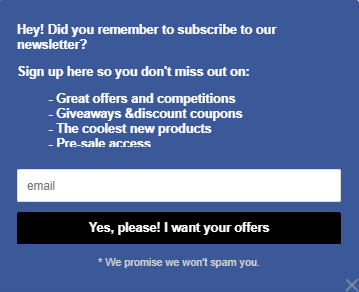
Here is an example Helm, a Danish brand, it uses an exit-intent campaign to entice the visitors to subscribe for their mailing list.
Here's another one that offers the visitors an opportunity to win their favourite bag.
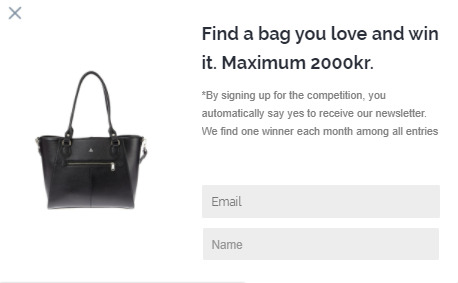
If a customer were about to churn, this exit-intent pop up presents them with a chance to avail 10% off on their first order. So ideally, it can turn customer attrition to customer conversion, which can boost your sales.
With most of the eCommerce software on the market, you have plenty of integrations available to integrate these tactics with your store.
Wrapping Up
The bottom line is FOMO marketing tactics if executed properly, can go a long way for eCommerce business. The main idea is to address the customers' pain points, create a situation that triggers FOMO and prompt them to take action.
Naturally, there is no definite approach that can be perfect for your business. You'll have to experiment and find what works best for you. The right strategy should target the right audience at the right time with the right offer.
Alongside FOMO, it is also imperative to pay attention to your website and continually make efforts to enhance its performance. Use the best tools to enhance its quality, design, and usability.
So, offer different opportunities to different people. While your email subscribers get excited about a discount offer, your Instagram followers can expect an entirely different thing.
The rise of social channels has heightened the use of FOMO marketing techniques. If you aim to benefit from FOMO for your ecommerce business, it can significantly help you generate sales.
Author's Bio
Will Cannon is the founder of UpLead and Signaturely. He believes in the importance of customer profiling, lead generation, customer acquisition and retention. Email marketing and customer relationship management are personal interests of his, as he has seen firsthand how these tactics can have a profound impact on business revenue.
from RSSMix.com Mix ID 8230801 https://ift.tt/3cTsbxI via IFTTT
0 notes
Text
Seasonal Email Marketing Campaigns: How to Make Your Halloween Campaign Stand Out

The time of the year when marketers discuss the design of the first of the most important seasonal email marketing campaigns is approaching fast.
I am talking about Halloween, of course, the time when lovers of all things spooky rejoice. No brand or marketer in their right mind would pass up on the opportunity to capitalize on this time of the year - or any time that would allow them to utilize the seer power that is a seasonal campaign.

According to the graph above, Halloween is one of the most fruitful commercial holidays. 8.8 billion dollars was spent on this holiday in 2019 alone. So why not take a slice of those earnings by creating a fantastic Halloween campaign?
Let's see how you're going to use seasonal email marketing to achieve the ROI of your dreams.
Start Early
Create a strategy or campaign that will make your prospects engage and use all arrows in your quiver to do so.
Create an engagement scheme and start writing content that will serve as a little "treat" for the "tricks" you're going to pull, marketing-wise. Start early, around the beginning of October, and keep them hooked and waiting for your next move.
1. Create Halloween Contests
Start by treating your prospects to a spooky and fun Halloween contest on social media. A Halloween giveaway would be ideal. You could go about it the way Dunkin' Donuts did.

Dunkin' Donuts held a competition on its social media platforms and created a branded hashtag for it: #DDCostumeContest. Now, not many people would go as a donut for Halloween; however, this contest was a huge success. And the prize - a feature on the Dunkin' billboard on Times Square, a year's supply of coffee, and $2,500 to boot - really did help!
The point here is that the competition generated tons of exposure for the brand, a lot of user engagement, and made the act go viral, all by utilizing User Generated Content (UGC).
Your brand can follow this tactic and pair it nicely with an optimized landing page, created solely for the needs of the competition. If your prospects want to be updated on the winner, they may enter their email. And there you have a Halloween contest that generates leads that are already interested and engaging with your Halloween content!
2. Create Extended Offers
Starting early and extending your Halloween contest, offer, or "treat" is essential. For the following reasons:
Prospects have all the time they need to decide on what they want. Of course, you can use a countdown timer to instill some FOMO in them.
Halloween could be on any day. A busy Monday or a slow Thursday will rob you of the traffic that your offer could generate on the weekend.
It shows just how much you care and will make prospects remember you.
Again, you can build up the anticipation with some great social media marketing. Phrases like "Subscribe to our newsletter for more info" will create a curated, interested email list in no time!
Oh, and do not forget the themed code for the offer:

It shows your whimsical side and will help people connect with you and your content.
3. Build Halloween Campaign Suspense!
Is it a trick? Is it a treat? Is it a deal? Your prospects' only way to know the answer to those questions is if they interact with your emails.
Create a cryptic message you could share on your social media that will be leaving hints at an offer. And then, create an email sequence that will keep your prospects hooked and make them interact with your email:

Get users to interact with your Halloween campaigns with a game or an interactive quiz that will capture their attention.
Starting early with an email that doesn't say much and building up to the big reveal right in time for Halloween is something that will help your click-through rate skyrocket, as well as your traffic.
Create Content To-Die-For
The tips above are all fine and well, but you need one key element to make them work, and that would be wonderful email copy and great social media content that can match that copy.
And I've got some tricks that will help you reach the "treat" of conversion. Now a high-converting seasonal email marketing campaign consists of excellent email copy - from the subject line to the CTAs-, content that is highly relevant and appealing, and, of course, visuals that will stay in a prospect's mind for a long, long time.
1. A Themed Subject Line
Your brand won't be the first or the last one to send your prospects a seasonal email marketing campaign, which can only mean one thing for you.
You need to dazzle them with some great email subject lines:

This one is an example out of my inbox, and let me tell you, I was very curious about what "all treat" and "no tricks" really meant.
In that case, I opened the email and saw a seasonal offer that I rushed to grab. So, the example above shows a clever seasonal wordplay that is equal parts playful and intriguing.
Use that tactic to make your recipients feel a little interested and curious about your offer. And if it's a limited time offer, use a timer or highlight the fact right off the bat.
Super Pro Tip: It should be a given, of course, but never take a step forward before consulting your data and A/B testing everything. This practice will give you insight into the type of content prospects want to receive and help you make educated decisions, backed by data.
2. Halloweeny Look
Wondering how to write content for your Halloween email marketing campaign is one thing that you need to get out of the way, sure. But what about the campaign's "looks"?
Just because your campaign is seasonal doesn't mean that you need to change your email layout completely. On the contrary, you can use the design your prospects love, but with a little twist.
Change the standard colors for something more "spooky". Like this:
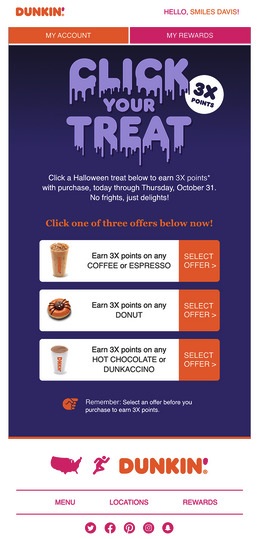
Dunkin's email is the perfect example, as the original font is right there, as well as the colors. However, there's some Halloween decor on this email: notice the dripping effect on the letters and the mix of Dunkin's original colors - pink and orange - with the more seasonal purple.
You can also create a different color scheme, depending on your target audience and the vibe you'd like your email to have: Be fun and classic with oranges, purples, and bats or creepy and horrific with greens, cauldrons, and zombies.
3. Fear Is Your Friend
You know how Halloween is all about fear and spooky things. Your Halloween email marketing campaign might be the only one you can build around fear, without making it unpleasant.
Of course, I'm talking about Fear Of Missing Out - or FOMO, if you will.
Use words that have to do with fear and being wicked and scary. Here's an email subject line to help set the mood:

No brand would use such language outside of Halloween, but at this specific time, it's appropriate and fitting. Not to mention that it brilliantly leads to the email body copy:

Offer's good "until midnight this Halloween," which is a pretty good reason to be scared, especially as a gamer. You see, creative copy for little offers like the one above keep customers happy and keep your CTR, traffic, and customer churn at the rates you want them to be. For more help here are 6 actionable steps to reduce customer churn on your ecommerce site.
4. Create a CTA That Takes the Cake
...Or the candy bar, whatever you prefer. The whole point is that your CTA needs to stand out and be as spooky and fun as the rest of your email.
Does this mean that it needs to be cryptic and overly creative? No. CTAs show prospects what their next action should be and lead them straight to your goals.
Don't swarm your email with copy, no matter your creative knack. Customers won't read all of your emails, but they will bother with three things: our subject line, email design, and CTA.
Go straight to the point when letting your readers know what you want from them. Of course, this doesn't mean that you have to be bland or boring. Check this CTA copy, and you'll see what I mean:

Also, don't forget to have one CTA button. Just the one. Otherwise, prospects will get a little confused about what your seasonal email marketing campaign is trying to do.
Honorable Mentions
Before I go, I'd like to remind you of some email marketing staples you need to implement on any campaign - apart from selecting the right email service, of course.
Keep a clean, well-curated email list. Unsubscribers can get you penalized, and the last thing you want is for your emails to end up in the dark corners of a spam folder.
Always segment your audience and create buyer personas and always consult your data before doing so.
Create responsive emails that will work correctly for any device. Mobile opens are taking over, and you don't want to miss out on that revenue.
Bonus: enjoy some best halloween ad campaigns and get some spooky inspiration!
Summing Up
Halloween is the holiday that marks the spending season, as Thanksgiving and Christmas follow soon after.
Don't be afraid to get creative and send out playful emails that can have a "magical" or "spooky" twist.
Just remember to adjust your tone of voice and copy, create a unique message, and save the prospect's time by not babbling too much in your email's body copy.
After all, the festive time of the year calls for presents and a little spending. Use the tips above, and you'll see that you can benefit from this.
About the Author

Téa Liarokapi is a content writer working for email marketing software company Moosend and an obsessive writer in general. In her free time, she tries to find new ways to stuff more books in her bookcase and content ideas-and cats-to play with.
from RSSMix.com Mix ID 8230801 https://ift.tt/3l00PXB via IFTTT
0 notes
Text
Seasonal Email Marketing Campaigns: How to Make Your Halloween Campaign Stand Out

The time of the year when marketers discuss the design of the first of the most important seasonal email marketing campaigns is approaching fast.
I am talking about Halloween, of course, the time when lovers of all things spooky rejoice. No brand or marketer in their right mind would pass up on the opportunity to capitalize on this time of the year - or any time that would allow them to utilize the seer power that is a seasonal campaign.

According to the graph above, Halloween is one of the most fruitful commercial holidays. 8.8 billion dollars was spent on this holiday in 2019 alone. So why not take a slice of those earnings by creating a fantastic Halloween campaign?
Let's see how you're going to use seasonal email marketing to achieve the ROI of your dreams.
Start Early
Create a strategy or campaign that will make your prospects engage and use all arrows in your quiver to do so.
Create an engagement scheme and start writing content that will serve as a little "treat" for the "tricks" you're going to pull, marketing-wise. Start early, around the beginning of October, and keep them hooked and waiting for your next move.
1. Create Halloween Contests
Start by treating your prospects to a spooky and fun Halloween contest on social media. A Halloween giveaway would be ideal. You could go about it the way Dunkin' Donuts did.

Dunkin' Donuts held a competition on its social media platforms and created a branded hashtag for it: #DDCostumeContest. Now, not many people would go as a donut for Halloween; however, this contest was a huge success. And the prize - a feature on the Dunkin' billboard on Times Square, a year's supply of coffee, and $2,500 to boot - really did help!
The point here is that the competition generated tons of exposure for the brand, a lot of user engagement, and made the act go viral, all by utilizing User Generated Content (UGC).
Your brand can follow this tactic and pair it nicely with an optimized landing page, created solely for the needs of the competition. If your prospects want to be updated on the winner, they may enter their email. And there you have a Halloween contest that generates leads that are already interested and engaging with your Halloween content!
2. Create Extended Offers
Starting early and extending your Halloween contest, offer, or "treat" is essential. For the following reasons:
Prospects have all the time they need to decide on what they want. Of course, you can use a countdown timer to instill some FOMO in them.
Halloween could be on any day. A busy Monday or a slow Thursday will rob you of the traffic that your offer could generate on the weekend.
It shows just how much you care and will make prospects remember you.
Again, you can build up the anticipation with some great social media marketing. Phrases like "Subscribe to our newsletter for more info" will create a curated, interested email list in no time!
Oh, and do not forget the themed code for the offer:

It shows your whimsical side and will help people connect with you and your content.
3. Build Halloween Campaign Suspense!
Is it a trick? Is it a treat? Is it a deal? Your prospects' only way to know the answer to those questions is if they interact with your emails.
Create a cryptic message you could share on your social media that will be leaving hints at an offer. And then, create an email sequence that will keep your prospects hooked and make them interact with your email:
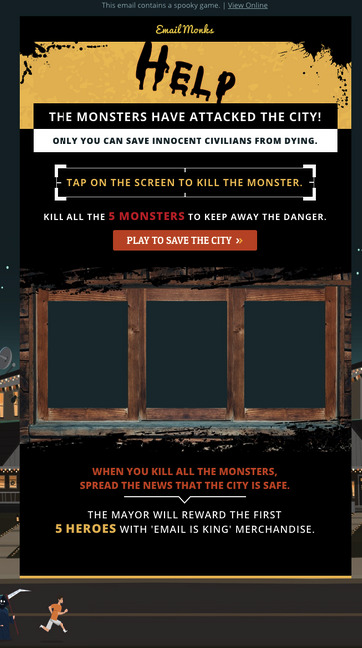
Get users to interact with your Halloween campaigns with a game or an interactive quiz that will capture their attention.
Starting early with an email that doesn't say much and building up to the big reveal right in time for Halloween is something that will help your click-through rate skyrocket, as well as your traffic.
Create Content To-Die-For
The tips above are all fine and well, but you need one key element to make them work, and that would be wonderful email copy and great social media content that can match that copy.
And I've got some tricks that will help you reach the "treat" of conversion. Now a high-converting seasonal email marketing campaign consists of excellent email copy - from the subject line to the CTAs-, content that is highly relevant and appealing, and, of course, visuals that will stay in a prospect's mind for a long, long time.
1. A Themed Subject Line
Your brand won't be the first or the last one to send your prospects a seasonal email marketing campaign, which can only mean one thing for you.
You need to dazzle them with some great email subject lines:

This one is an example out of my inbox, and let me tell you, I was very curious about what "all treat" and "no tricks" really meant.
In that case, I opened the email and saw a seasonal offer that I rushed to grab. So, the example above shows a clever seasonal wordplay that is equal parts playful and intriguing.
Use that tactic to make your recipients feel a little interested and curious about your offer. And if it's a limited time offer, use a timer or highlight the fact right off the bat.
Super Pro Tip: It should be a given, of course, but never take a step forward before consulting your data and A/B testing everything. This practice will give you insight into the type of content prospects want to receive and help you make educated decisions, backed by data.
2. Halloweeny Look
Wondering how to write content for your Halloween email marketing campaign is one thing that you need to get out of the way, sure. But what about the campaign's "looks"?
Just because your campaign is seasonal doesn't mean that you need to change your email layout completely. On the contrary, you can use the design your prospects love, but with a little twist.
Change the standard colors for something more "spooky". Like this:
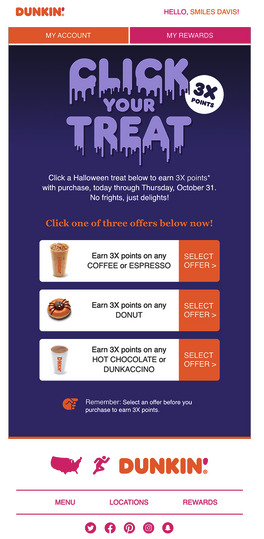
Dunkin's email is the perfect example, as the original font is right there, as well as the colors. However, there's some Halloween decor on this email: notice the dripping effect on the letters and the mix of Dunkin's original colors - pink and orange - with the more seasonal purple.
You can also create a different color scheme, depending on your target audience and the vibe you'd like your email to have: Be fun and classic with oranges, purples, and bats or creepy and horrific with greens, cauldrons, and zombies.
3. Fear Is Your Friend
You know how Halloween is all about fear and spooky things. Your Halloween email marketing campaign might be the only one you can build around fear, without making it unpleasant.
Of course, I'm talking about Fear Of Missing Out - or FOMO, if you will.
Use words that have to do with fear and being wicked and scary. Here's an email subject line to help set the mood:

No brand would use such language outside of Halloween, but at this specific time, it's appropriate and fitting. Not to mention that it brilliantly leads to the email body copy:
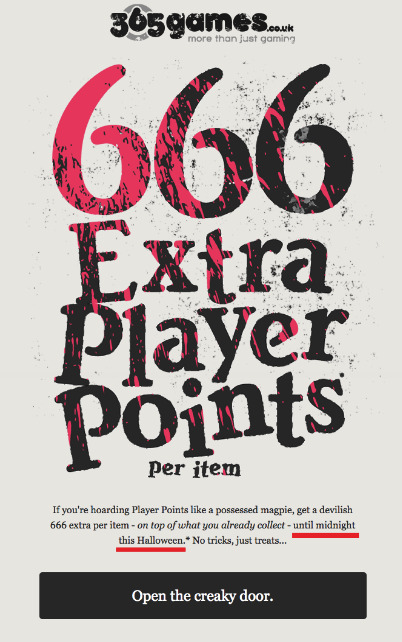
Offer's good "until midnight this Halloween," which is a pretty good reason to be scared, especially as a gamer. You see, creative copy for little offers like the one above keep customers happy and keep your CTR, traffic, and customer churn at the rates you want them to be. For more help here are 6 actionable steps to reduce customer churn on your ecommerce site.
4. Create a CTA That Takes the Cake
...Or the candy bar, whatever you prefer. The whole point is that your CTA needs to stand out and be as spooky and fun as the rest of your email.
Does this mean that it needs to be cryptic and overly creative? No. CTAs show prospects what their next action should be and lead them straight to your goals.
Don't swarm your email with copy, no matter your creative knack. Customers won't read all of your emails, but they will bother with three things: our subject line, email design, and CTA.
Go straight to the point when letting your readers know what you want from them. Of course, this doesn't mean that you have to be bland or boring. Check this CTA copy, and you'll see what I mean:

Also, don't forget to have one CTA button. Just the one. Otherwise, prospects will get a little confused about what your seasonal email marketing campaign is trying to do.
Honorable Mentions
Before I go, I'd like to remind you of some email marketing staples you need to implement on any campaign - apart from selecting the right email service, of course.
Keep a clean, well-curated email list. Unsubscribers can get you penalized, and the last thing you want is for your emails to end up in the dark corners of a spam folder.
Always segment your audience and create buyer personas and always consult your data before doing so.
Create responsive emails that will work correctly for any device. Mobile opens are taking over, and you don't want to miss out on that revenue.
Bonus: enjoy some best halloween ad campaigns and get some spooky inspiration!
Summing Up
Halloween is the holiday that marks the spending season, as Thanksgiving and Christmas follow soon after.
Don't be afraid to get creative and send out playful emails that can have a "magical" or "spooky" twist.
Just remember to adjust your tone of voice and copy, create a unique message, and save the prospect's time by not babbling too much in your email's body copy.
After all, the festive time of the year calls for presents and a little spending. Use the tips above, and you'll see that you can benefit from this.
About the Author

Téa Liarokapi is a content writer working for email marketing software company Moosend and an obsessive writer in general. In her free time, she tries to find new ways to stuff more books in her bookcase and content ideas-and cats-to play with.
from RSSMix.com Mix ID 8230801 https://ift.tt/3l00PXB via IFTTT
0 notes
Text
Seasonal Email Marketing Campaigns: How to Make Your Halloween Campaign Stand Out

The time of the year when marketers discuss the design of the first of the most important seasonal email marketing campaigns is approaching fast.
I am talking about Halloween, of course, the time when lovers of all things spooky rejoice. No brand or marketer in their right mind would pass up on the opportunity to capitalize on this time of the year - or any time that would allow them to utilize the seer power that is a seasonal campaign.

According to the graph above, Halloween is one of the most fruitful commercial holidays. 8.8 billion dollars was spent on this holiday in 2019 alone. So why not take a slice of those earnings by creating a fantastic Halloween campaign?
Let's see how you're going to use seasonal email marketing to achieve the ROI of your dreams.
Start Early
Create a strategy or campaign that will make your prospects engage and use all arrows in your quiver to do so.
Create an engagement scheme and start writing content that will serve as a little "treat" for the "tricks" you're going to pull, marketing-wise. Start early, around the beginning of October, and keep them hooked and waiting for your next move.
1. Create Halloween Contests
Start by treating your prospects to a spooky and fun Halloween contest on social media. A Halloween giveaway would be ideal. You could go about it the way Dunkin' Donuts did.

Dunkin' Donuts held a competition on its social media platforms and created a branded hashtag for it: #DDCostumeContest. Now, not many people would go as a donut for Halloween; however, this contest was a huge success. And the prize - a feature on the Dunkin' billboard on Times Square, a year's supply of coffee, and $2,500 to boot - really did help!
The point here is that the competition generated tons of exposure for the brand, a lot of user engagement, and made the act go viral, all by utilizing User Generated Content (UGC).
Your brand can follow this tactic and pair it nicely with an optimized landing page, created solely for the needs of the competition. If your prospects want to be updated on the winner, they may enter their email. And there you have a Halloween contest that generates leads that are already interested and engaging with your Halloween content!
2. Create Extended Offers
Starting early and extending your Halloween contest, offer, or "treat" is essential. For the following reasons:
Prospects have all the time they need to decide on what they want. Of course, you can use a countdown timer to instill some FOMO in them.
Halloween could be on any day. A busy Monday or a slow Thursday will rob you of the traffic that your offer could generate on the weekend.
It shows just how much you care and will make prospects remember you.
Again, you can build up the anticipation with some great social media marketing. Phrases like "Subscribe to our newsletter for more info" will create a curated, interested email list in no time!
Oh, and do not forget the themed code for the offer:

It shows your whimsical side and will help people connect with you and your content.
3. Build Halloween Campaign Suspense!
Is it a trick? Is it a treat? Is it a deal? Your prospects' only way to know the answer to those questions is if they interact with your emails.
Create a cryptic message you could share on your social media that will be leaving hints at an offer. And then, create an email sequence that will keep your prospects hooked and make them interact with your email:

Get users to interact with your Halloween campaigns with a game or an interactive quiz that will capture their attention.
Starting early with an email that doesn't say much and building up to the big reveal right in time for Halloween is something that will help your click-through rate skyrocket, as well as your traffic.
Create Content To-Die-For
The tips above are all fine and well, but you need one key element to make them work, and that would be wonderful email copy and great social media content that can match that copy.
And I've got some tricks that will help you reach the "treat" of conversion. Now a high-converting seasonal email marketing campaign consists of excellent email copy - from the subject line to the CTAs-, content that is highly relevant and appealing, and, of course, visuals that will stay in a prospect's mind for a long, long time.
1. A Themed Subject Line
Your brand won't be the first or the last one to send your prospects a seasonal email marketing campaign, which can only mean one thing for you.
You need to dazzle them with some great email subject lines:

This one is an example out of my inbox, and let me tell you, I was very curious about what "all treat" and "no tricks" really meant.
In that case, I opened the email and saw a seasonal offer that I rushed to grab. So, the example above shows a clever seasonal wordplay that is equal parts playful and intriguing.
Use that tactic to make your recipients feel a little interested and curious about your offer. And if it's a limited time offer, use a timer or highlight the fact right off the bat.
Super Pro Tip: It should be a given, of course, but never take a step forward before consulting your data and A/B testing everything. This practice will give you insight into the type of content prospects want to receive and help you make educated decisions, backed by data.
2. Halloweeny Look
Wondering how to write content for your Halloween email marketing campaign is one thing that you need to get out of the way, sure. But what about the campaign's "looks"?
Just because your campaign is seasonal doesn't mean that you need to change your email layout completely. On the contrary, you can use the design your prospects love, but with a little twist.
Change the standard colors for something more "spooky". Like this:
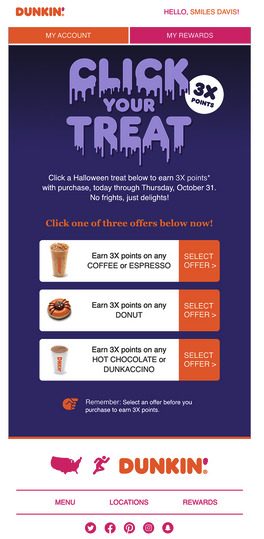
Dunkin's email is the perfect example, as the original font is right there, as well as the colors. However, there's some Halloween decor on this email: notice the dripping effect on the letters and the mix of Dunkin's original colors - pink and orange - with the more seasonal purple.
You can also create a different color scheme, depending on your target audience and the vibe you'd like your email to have: Be fun and classic with oranges, purples, and bats or creepy and horrific with greens, cauldrons, and zombies.
3. Fear Is Your Friend
You know how Halloween is all about fear and spooky things. Your Halloween email marketing campaign might be the only one you can build around fear, without making it unpleasant.
Of course, I'm talking about Fear Of Missing Out - or FOMO, if you will.
Use words that have to do with fear and being wicked and scary. Here's an email subject line to help set the mood:

No brand would use such language outside of Halloween, but at this specific time, it's appropriate and fitting. Not to mention that it brilliantly leads to the email body copy:
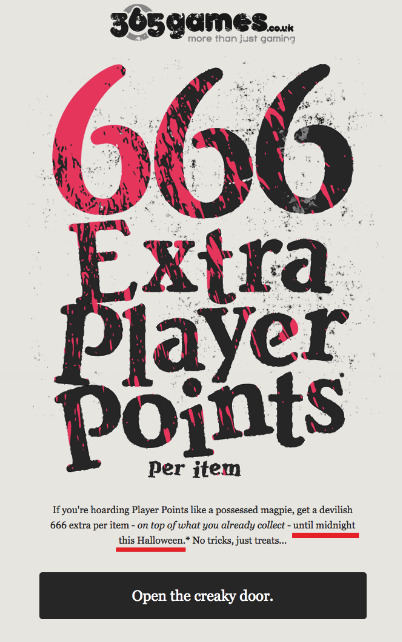
Offer's good "until midnight this Halloween," which is a pretty good reason to be scared, especially as a gamer. You see, creative copy for little offers like the one above keep customers happy and keep your CTR, traffic, and customer churn at the rates you want them to be. For more help here are 6 actionable steps to reduce customer churn on your ecommerce site.
4. Create a CTA That Takes the Cake
...Or the candy bar, whatever you prefer. The whole point is that your CTA needs to stand out and be as spooky and fun as the rest of your email.
Does this mean that it needs to be cryptic and overly creative? No. CTAs show prospects what their next action should be and lead them straight to your goals.
Don't swarm your email with copy, no matter your creative knack. Customers won't read all of your emails, but they will bother with three things: our subject line, email design, and CTA.
Go straight to the point when letting your readers know what you want from them. Of course, this doesn't mean that you have to be bland or boring. Check this CTA copy, and you'll see what I mean:

Also, don't forget to have one CTA button. Just the one. Otherwise, prospects will get a little confused about what your seasonal email marketing campaign is trying to do.
Honorable Mentions
Before I go, I'd like to remind you of some email marketing staples you need to implement on any campaign - apart from selecting the right email service, of course.
Keep a clean, well-curated email list. Unsubscribers can get you penalized, and the last thing you want is for your emails to end up in the dark corners of a spam folder.
Always segment your audience and create buyer personas and always consult your data before doing so.
Create responsive emails that will work correctly for any device. Mobile opens are taking over, and you don't want to miss out on that revenue.
Bonus: enjoy some best halloween ad campaigns and get some spooky inspiration!
Summing Up
Halloween is the holiday that marks the spending season, as Thanksgiving and Christmas follow soon after.
Don't be afraid to get creative and send out playful emails that can have a "magical" or "spooky" twist.
Just remember to adjust your tone of voice and copy, create a unique message, and save the prospect's time by not babbling too much in your email's body copy.
After all, the festive time of the year calls for presents and a little spending. Use the tips above, and you'll see that you can benefit from this.
About the Author

Téa Liarokapi is a content writer working for email marketing software company Moosend and an obsessive writer in general. In her free time, she tries to find new ways to stuff more books in her bookcase and content ideas-and cats-to play with.
from RSSMix.com Mix ID 8230801 https://ift.tt/3l00PXB via IFTTT
0 notes